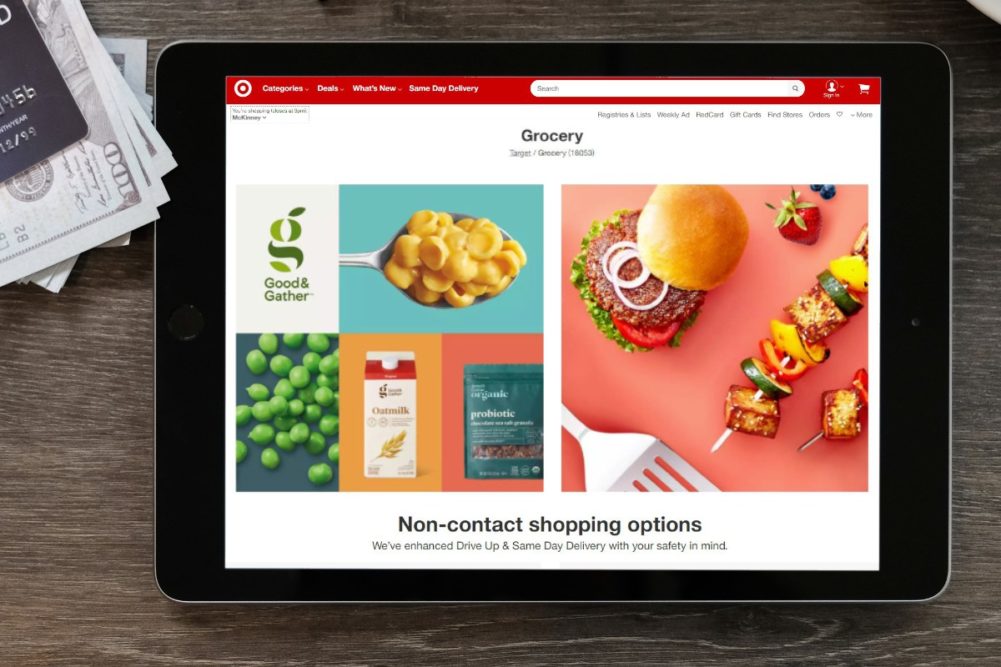MINNEAPOLIS – The surge in retail demand during the month of March propelled Target Corp.’s sales in its first quarter of fiscal 2020. Some of the retailer’s metrics during the period were unprecedented – total comparable store sales up 10.8%; digital comparable growth of 140%; and food and beverage comparable sales grew 20%.
“It goes without saying but this quarter was unlike anything we’ve seen in our company’s long history,” said Brian C. Cornell, chairman and chief executive officer, during a May 20 conference call with financial analysts to discuss results.
Net income for the quarter ended May 2 totaled $284 million, equal to 57¢ per share on the common stock, down when compared with the same period of the previous year when the company earned $795 million, or $1.54 per share.
Sales for the quarter rose 11.3% to $19.4 billion.
The decreased net income was due to an 18% increase in the cost of sales to $14 billion. Selling, general and administration expenses rose 11% during the quarter to $4 billion. Actions taken by the company that affected earnings included higher merchandising costs and inventory impairments related to the rapid slowdown in apparel and accessories sales, unfavorable category mix as guests stocked up on lower-margin categories like essentials, food and beverage, and higher digital and supply chain costs, driven by unusually strong digital volume as well as investments in team member wages and benefits, according to the company.
“As I reflect on all that’s transpired since the quarter began in February, there were two key factors in our success: our strategy of positioning stores and fulfillment hubs and our unbelievable team,” Cornell said. “When guests began flocking to our stores to stock up, our team was ready. And when digital demand exploded as guests began to shelter in place, our teams have the tools, processes and capability to flex to meet that shift in demand.”
Cornell added that the numbers did not provide enough context to how quickly market conditions changed.
“We began the quarter with a relatively normal February, in which we saw overall comp growth of 3.8% and digital comp growth of 33%, and ended in April, which saw total company comp growth of more than 16% and a jaw-dropping 282% increase in digital comp sales,” he said. “To put this volume into perspective, on an average day in April, our operations were fulfilling many more items and orders than last year’s Cyber Monday, a day for which we had planned months ahead of time.”
John J. Mulligan, chief operating officer, said food and beverage comps moved from the single digits in mid-February to above 50% in March before settling in the teens in April.
“We’ve seen a dramatic increase in the pace of sales causing out-of-stocks to rise well above where we’d like them to be,” he said. “In need-based categories like food and beverage and essentials where comps have accelerated into the 20% range, we have been on allocation from multiple vendors as they work to ramp up production to cover the higher level of demand.”
He added that the coronavirus is causing an acceleration in consumer trial and adoption of digital shopping.
“The ability of our operations to handle this unexpected acceleration has given us even stronger conviction that we have the right model and we have ample capacity to handle continued change in the future,” Mulligan said. “Specifically, as part of our long-range plans at the beginning of 2020, our first-quarter digital volumes weren’t anticipated for another three years, but our operations accommodated that extra volume without any advanced planning.”
In April, sales through the retailer’s drive-up sales channel increased nearly 1,000% compared to the same period of the previous year.
“These growth numbers reflect the fact that drive-up continues to be our most popular service and the number of guests who are trying and repeatedly using drive-up continues to increase rapidly,” Mulligan said. “Specifically, more than 5 million guests used our drive-up service in the first quarter, with 40% of these guests new to the service.”
In late March Target Corp. withdrew its full-year guidance due to the uncertainty of market conditions. The company said it will not offer guidance in the near future.
“From today’s perspective, the one thing that seems most certain is continued volatility, and whenever possible, we’re building flexibility into our plans and commitments,” Cornell said. “But let me be clear, the expectation of continued volatility in the external environment doesn’t translate to a lack of confidence about our future.”

